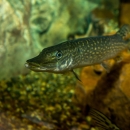States
CaliforniaDeclining salmon populations in rivers along the western U.S. have been exacerbated by recent droughts, habitat fragmentation, and the effects of climate change climate change
Climate change includes both global warming driven by human-induced emissions of greenhouse gases and the resulting large-scale shifts in weather patterns. Though there have been previous periods of climatic change, since the mid-20th century humans have had an unprecedented impact on Earth's climate system and caused change on a global scale.
Learn more about climate change . Growing competition for limited water resources and continued habitat degradation are increasing the risks of population extinction and need for accelerated protection and habitat restoration efforts. Investments across the region will help restore Northern California watersheds that are strongholds for salmon by addressing some of the most significant threats to these once thriving fisheries - removing structural barriers, restoring access to floodplain habitat, and addressing low flow barriers caused by extended drought and climate change.
Project Quick Facts
- Location: Northern California
- BIL Investments to Date: $40,000,000+
- Total restoration costs: $50,000,000+
- Type of barriers: Dams, culverts, instream flow, water management
- Non-Federal Partners Include: State of California, Trout Unlimited, The Nature Conservancy, California Trout, California Fish Passage Forum, Wildlife Conservation Board, Local and Tribal Partners
- Federal Agencies Invested to Date: National Marine Fisheries Service, Bureau of Reclamation, Federal Highway Administration, U.S. Fish and Wildlife Service, National Park Service
Removing Barriers to Success
A landscape-scale approach is needed to fix legacy watershed degradation and by leveraging existing efforts, such as the California Salmon Strategy and Salmon Habitat Restoration Priorities plans and other investments by partners across the region, we know that strategic investments can have substantial and near-term impacts on species, ecosystems, and communities.
The Importance of Transformational Fish Passage Projects
This project is one of over 70 grand-scale, community-centric restoration projects, identified by the Federal Interagency Fish Passage Task Force, that not only rejuvenate ecosystems but also bolster the climate resilience and economies of communities across the country. Learn more about these ground breaking projects in our Reviving Rivers, Reconnecting Communities story map.



